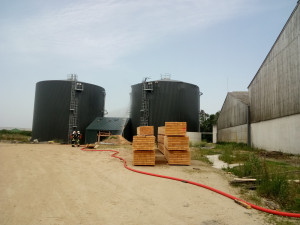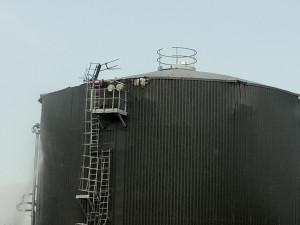An explosion occurred, followed by a fire at around 2:40 p.m. in a 15-meter-high digester containing 300 m³ of slurry. A fireball was seen. The fire brigade performed explosivity and H2S measurements within the enclosure, and the electricity was disconnected in the area. The fire spread through the double walls of the tank and its rock wool insulation. At around 7 p.m., the firefighters cleared the roof of the digester while continuing to cool down the walls. The digester contents were removed by a series of slurry tankers and then transferred to the neighbouring post-digester. After opening the upper part of the tank, a thermal camera was used to take readings. Once the temperature had dropped to 30 °C, the rescue plan was lifted at 9:30 p.m.
During the operation, one fireman suffered from heatstroke, and two people were treated for shock. The digester had been deformed in the explosion, and the roof had been blown off, leading to the ejection of a small quantity of slurry. The soil that had been impacted was collected in a skip and taken for treatment. The digester had to be rebuilt.
The 2,500 m³ digester was part of a methanisation unit that was being installed. The gas piping had not yet been connected, and the operator had not yet accepted the installation. The technical safety file to be completed before commissioning had not been sent to the authorities. However, manure slurry was already being stored there, which was not compliant with the applicable regulations.
The explosion occurred while subcontractors were grounding a device to weld the gas pipes. The operator stated that the subcontractors had been informed that liquid manure was present in the tank, creating a risk of an explosive atmosphere, but that no ATEX zoning had been established.
Following the visit by the Classified Installations Inspectorate, formal notice and an emergency measures order were issued. The operator transferred the slurry from the post-digester to an aerated buffer tank to prevent an explosive atmosphere from forming.
The accident revealed that the risks concerning the safety issues involved with this type of installation had been underestimated. The operator explained that it was eager to start filling the digester owing to its obligation to honour an electricity buy-back contract and a contract to recover effluents from farmers. Following the accident, the operator wanted to begin operating the methanisation unit with the post-digester alone (a situation that can be considered to manage maintenance cases, for example) without waiting for the digester to be rebuilt. The inspection required prior submission of the technical safety file, justification of the technical feasibility of operation with a single digester without degrading the expected performance levels, and, if necessary, the proposal of appropriate safety measures to manage the co-activity phase of digester reconstruction/post-digester operation.
Following the accident, the operator reminded its subcontractor of the safety instructions and rules. The responsibilities of each party (operator/subcontractor) concerning the controls to be carried out are specified.
Hot spot works can no longer be carried out on-site on the installation’s equipment but rather in a dedicated area for workshop trucks (welding station, grinder, disc machine, etc.).





